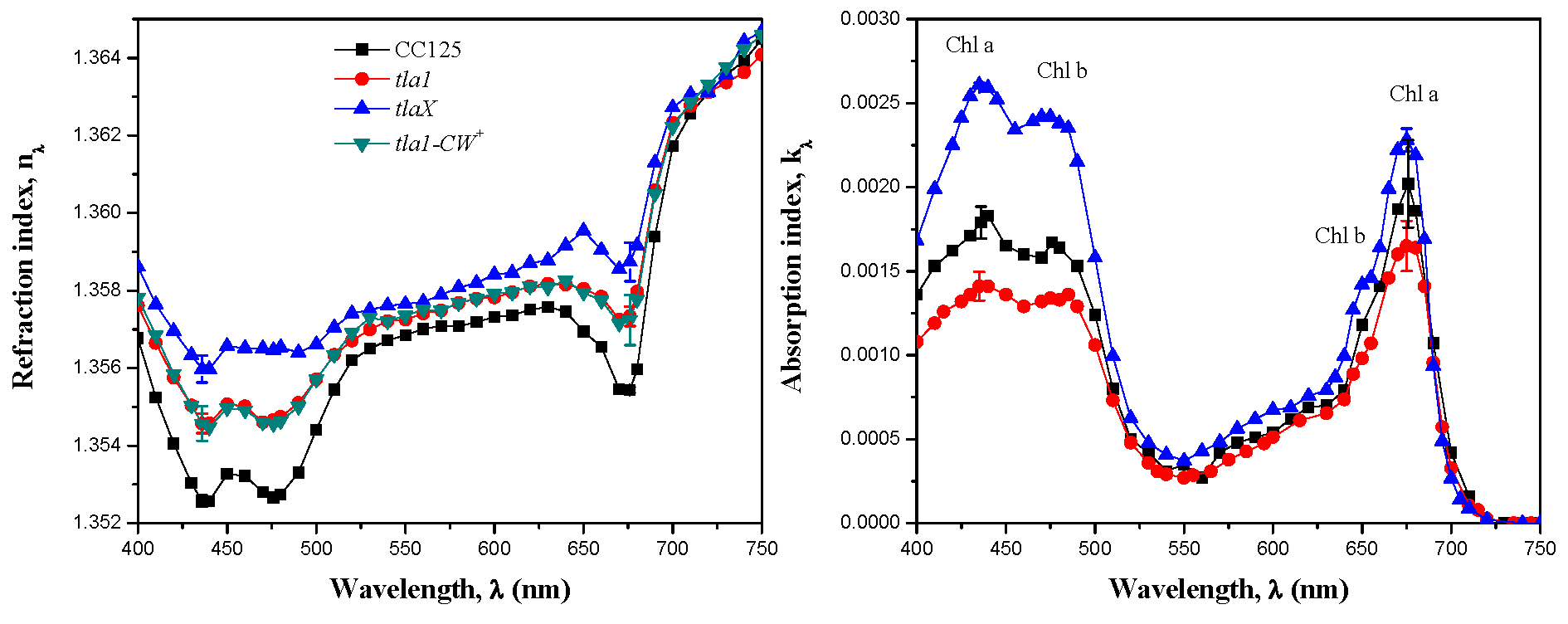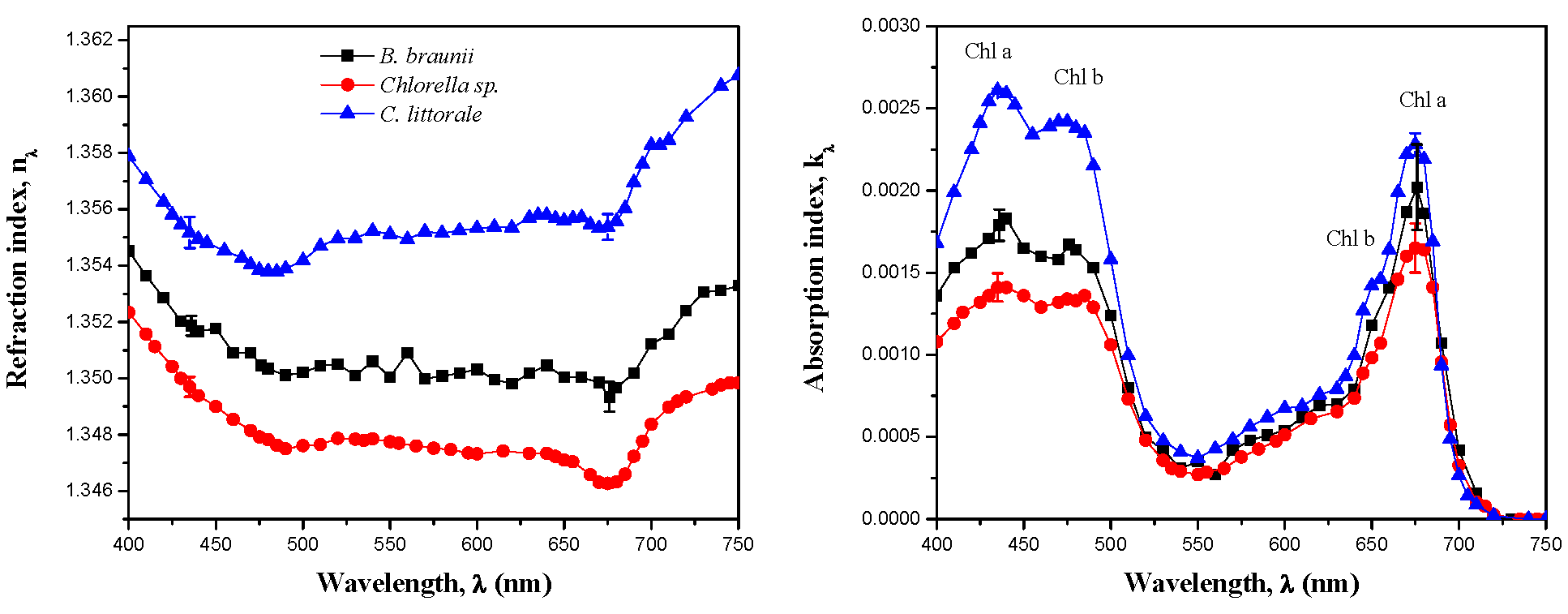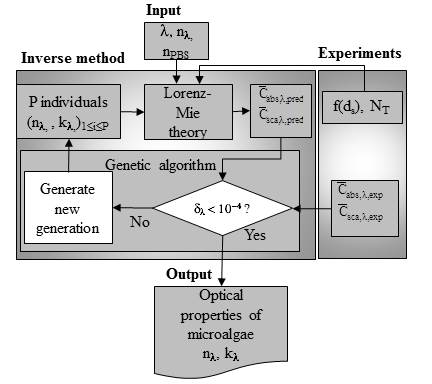Introduction
The present study aims to retrieve the spectral real part (or refraction index) and imaginary part (absorption index) of the complex index of refraction of microalgae from experimentally measured size distribution as well as absorption and scattering cross-sections. The green algae Chlamydomonas reinhardtii strain CC125 and its truncated chlorophyll antenna transformants tla1, tlaX, and tla1-CW+ as well as Botryococcus braunii, Chlorella sp., and Chlorococcum littorale were considered in this study. Finally, the results were used to retrieve the microalgae pigment concentrations and gain insight into their composition.
Analysis
In the present study, the different microalgae were assumed to be spherical. This assumption simplifies the calculations of their radiation characteristics by using the Lorenz–Mie theory instead of the T-matrix method. Moreover, despite their heterogeneous structure, microalgae were treated as homogeneous with some effective refraction and absorption indices. The different microalgae were treated as homogeneous spheres with an equivalent diameter such that their surface area was identical to that of their actual spheroidal shape assumed to be axisymmetric. The equivalent diameter of the sphere having the same surface area as the spheroid is given by

where a and b are the major and minor diameters, respectively. The spheroid aspect ratio is defined as ε = a/b. Moreover, the number frequency of equivalent diameter ds is denoted by denoted by f(ds) is defined as
.jpg)
where N(ds) is the number of cells per unit volume of suspension having diameter between ds and ds+dds. The denominator on the right-hand side is the total cell concentration NT expressed in total number of cells per m3 of suspension. The Lorenz-Mie theory predicts the absorption and scattering cross-sections denoted by Cabs,λ and Csca,λ (expressed in m2) of an individual spherical cell of diameter ds with complex index of refraction nλ + ikλ submerged in phosphate buffered saline (PBS) solution with refraction index nPBS. Then, the absorption coefficient κλ and scattering coefficient σs,λ of a microorganism suspension with size distribution N(ds) is expressed as
![]()
Here, Cabs,λ and Csca,λ are the average absorption and scattering cross-sections of the microalgae in suspension (in m2), respectively. These average cross-sections can effectively be measured for typically polydisperse microalgae population. In fact, Berberoğlu et al.(2008) measured the average absorption and scattering cross-sections Cabs,λ and Csca,λ for B. braunii, Chlorella sp., and C. littorale. They also measured the average mass absorption Cabs,λ and scattering Csca,λ cross-sections of C. reinhardtii and its mutants. These mass cross-sections were converted into Cabs,λ and Csca,λ by the cells’ density and volume water fraction. Thus, the predictions from Lorenz-Mie theory could be directly compared with experimental data.
Fig. 1 shows the schematic diagram of the procedure used to simultaneously retrieve the spectral refraction index nλ and the absorption index kλ. The Lorentz-Mie theory was employed in the forward model to calculate the spectral average absorption and scattering cross-sections Cabs,λ and Csca,λ over the photoactive photosynthetic active radiation region. In the present study, genetic algorithm was implemented using the general purpose function optimization code PIKAIA. For each wavelength, the objective function δλ was defined as,
|
Fig. 1. Block diagram of the procedure used to retrieve the refraction index nλ and absorption index kλ from the absorption and scattering cross-sections Cabs,λ and Csca,λ at a given wavelength &lambda for number frequency f(ds).We used P=120 individuals per generation for a maximum of 50 generations. |
Results
Fig. 2 compares the effective refraction and absorptio nindices of C. reinhardtii CC 125 and its truncated chlorophyll antenna transformants tla1, tlaX, and tla1-CW+ between 400 and 750 nm. Overall, nλ varied slightly from one strain to another.On the other hand, Fig. 2 clearly shows that the absorption index decreases from CC125 to tla1-CW+, tla1, and tlaX corresponding to a reduction in the size of their chlorophyll antenna. A significant decrease in kλwas apparent for tlaX at wavelength 475 nm corresponding to a decrease in Chl b concentration caused by genetic engineering. In addition, tla1-CW+ features an absorption index larger than tla1 possibly due to the presence of a cell wall.

Fig. 2. Comparison of the retrieved refraction and absorption indices between 400 and 750 nm for the green algae C. reinhardtii CC 125 and its truncated chlorophyll antenna transformants tla1, tlaX, and tla1-CW+.
Fig. 3 shows the retrieved effective refraction and absorption indices for B. braunii, Chlorella sp., and C. littorale between 400 and 750 nm from the measured absorption and scattering cross-sections. Their refraction index nλ varied slightly between 1.345 and 1.36. indicatesthat C. littorale had the largest absorption index kλ while B. braunii and Chlorella sp. featured similar absorption indices across the PAR. Here also, kλ features absorption peaks at 435, 475, and 676 nm corresponding to the absorption peaks of in vivo Chl a and Chl b. It is interesting to note that the absorption cross-section of B. braunii was larger than those of C. littorale and Chlorella sp. which were similar despite the fact that C. littorale were much smaller than B. braunii, and Chlorella sp. However,the dry mass fraction of Chl a+b was (a) 1.9% in C. littorale, (b) 0.22–0.56% in B. braunii, and (c) 0.4–1.41% in Chlorella sp.. This may explain why C. littorale had the largest absorption index kλ and B.braunii and Chlorella sp. were found to have similar kλ.

Fig. 3. Comparison of the retrieved refraction and absorption indices between 400 and 750 nm for B. braunii, Chlorella sp., and C. littorale.
Conclusion
This study presented and used a methodology to retrieve the spectral refraction and absorption indices of various biofuel producing microalgae from experimentally measured average absorption and scattering cross-sections between 400 and 750 nm. The microalgae were treated as spherical particles with equivalent diameter distributions calculated from experimentally measured major and minor diameter distributions. An inverse method was developed combining Lorenz-Mie theory as the forward method and genetic algorithm. The retrieved refraction and absorption indices were continuous function of wavelength with apparent absorption peaks corresponding to those of Chl a and Chl b. These optical properties can be used to predict the radiation characteristics of the species considered using Lorenz-Mie theory or the T-matrix method for a given size distribution and average aspect ratio.
Publications
E. Lee, R.-L. Heng, and L. Pilon, 2013. Optical Constants of C.reinhardtii, Its Truncated Chlorophyll Antenna Transformants, and Other Biofuel Producing Microalgae. Journal of Quantitative Spectroscopy and Radiation Transfer, Vol. 114, pp.122-135. doi:10.1016/j.jqsrt.2012.08.012. pdf
H. Berberoğlu, L. Pilon, and A. Melis, 2008. Radiation Characteristics of Chlamydomonas reinhardtiiCC125 and Its Truncated Chlorophyll Antenna Transformants tla1, tlaX, and 37RP1-tla1, International Journal of Hydrogen Energy, Vol. 33, No.22, pp. 6467–6483. doi:10.1016/j.ijhydene.2008.07.071 pdf

